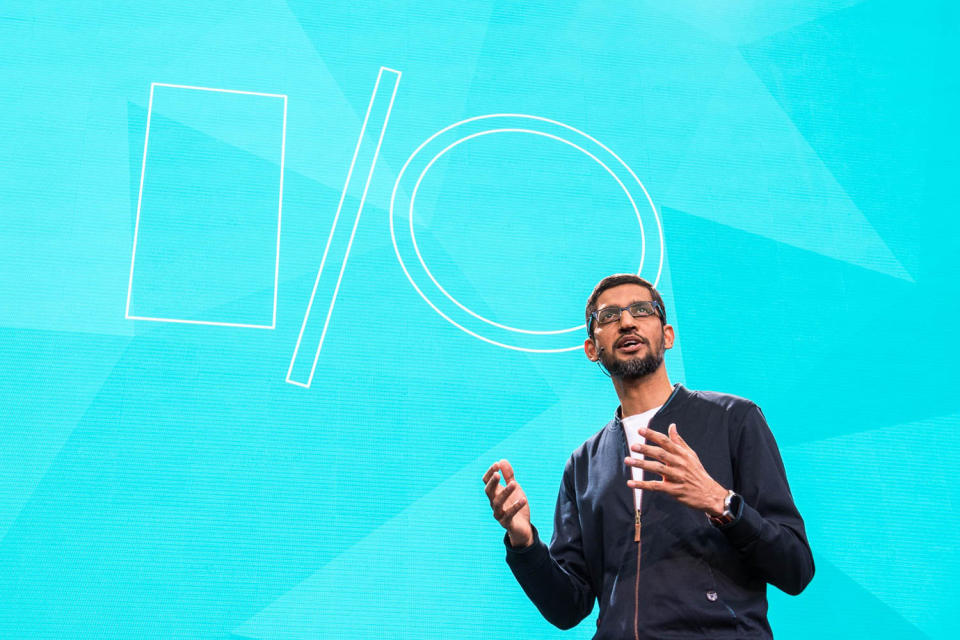The most important announcements from Google's big developers' conference
If this is May, it must be time for Google I/O.
That would be Google’s 10th annual developers’ conference. Like most devcons these days, its primary audience is software writers. But the opening keynote unveiled lots of developments that even non-nerds can understand: new features coming soon to Google products.
CEO Sundar Pichai opened his keynote speech with an observation: That Google (GOOG, GOOGL) may have begun life as a search company, but it’s now become an artificial intelligence (AI) company. Examples were everywhere.
Google Lens, Assistant, Photos
For example, he announced a new technology called Google Lens, which you can think of as Shazam for the whole world.
For example, you can point the camera at a flower, a building, a painting, a book cover, a restaurant storefront. The app recognizes what you’re looking at, and instantly gives you information: identification of the flower, ratings for the restaurant, and so on. Or you can point the camera at a marquee of a rock concert; Google Lens offers buttons for Play Music, Buy Tickets, or Add to Calendar.

Google Lens is part of Google Assistant, Google’s broader voice-assistant technology. Assistant is built into every Android phone, and is now available as an iPhone app. And you can now type questions and commands to Assistant instead of speaking them, if you prefer.
Google Photos, the company’s free, unlimited-storage online photo gallery, has always been able to identify who is in each photo. Now, if it spots, say, your brother in a photo, it offers to send that picture to him. Creepy, but convenient.
Google Home
Google announced improvements in its Google Home device, too (basically Google’s version of the Amazon Echo). For example, proactive notifications. If the Home learns something that you might find important—a traffic delay for an upcoming appointment, or a flight delay—its ring glows to get your attention. When you say “OK Google, what’s up?”, it tells you.
Second, free phone calls. You can say “OK Google, call mom,” and the Home acts as a futuristic speakerphone. It can call any land-line or mobile number in Canada or US for free. (This is not the same thing that Amazon added to its Echo last week—free calls between Amazon Echos or Amazon apps. This is free phone calls to phone numbers.)
Finally, Google Home can now send certain of its responses to a nearby screen, like your phone or TV. If you’ve asked for directions, it can throw a map onto your phone, for example.
Android ‘O’
Finally, Google announced the availability of the beta version of the next Android operating system for phones. The promised enhancements are almost comically small: a picture-in-picture mode for videos, redesigned emoji, faster startup, notification dots on app icons (like the iPhone does), color text in notifications.
There’s also a slimmed-down version of Android, called Android Go, for underpowered, cheap phones used in third-world countries. It uses far less horsepower and cellular data than the full-blown Android.
The most important new feature, Google didn’t even mention in the keynote: a new technology that may let Android phones upgrade to new versions of Android without having to wait a couple of years for the cellular company to get its actually together. (Details here.)
Overall, it’s clear that artificial intelligence and machine learning are indeed becoming Google’s new focus. Maybe next year, they should call the conference Google A/I.
More from David Pogue:
Inside the World’s Greatest Scavenger Hunt: Part 1 • Part 2 • Part 3 • Part 4 • Part 5
Google Home’s mastermind has no intention of losing to Amazon
Google exec explains how Google Assistant just got smarter
Amazon’s Alexa calling is like a Jetsons version of the home phone


